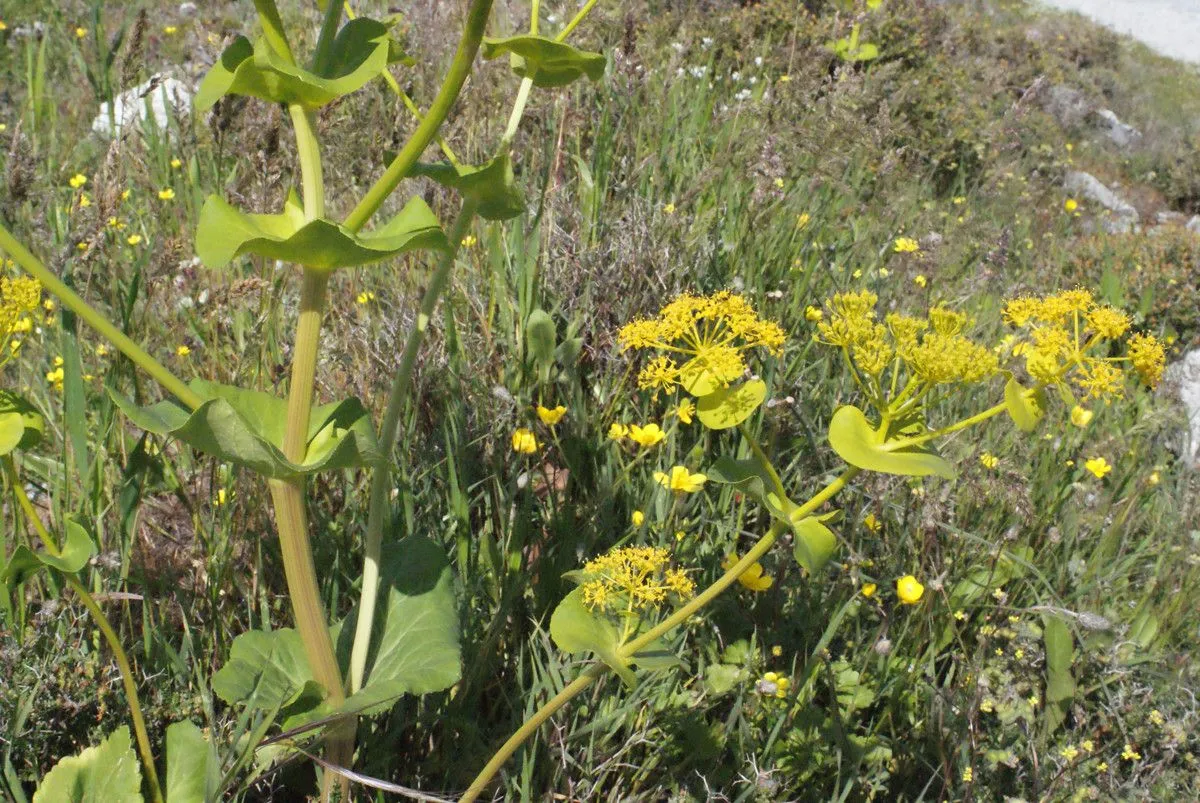
Author: L.
Bibliography: Sp. Pl.: 262 (1753)
Year: 1753
Status: accepted
Rank: species
Genus: Smyrnium
Vegetable: False
Observations: EC. Europe to Medit. and Caucasus
Perfoliate Alexanders, known scientifically as Smyrnium perfoliatum, is a fascinating flowering plant belonging to the Apiaceae family. This species holds a place of note in botanical literature, being first detailed by the renowned botanist Carl Linnaeus in 1753 in his Species Plantarum, a pivotal work in the field of taxonomy.
Perfoliate alexanders is native to a broad geographic region, stretching from Eastern and Central Europe down through the Mediterranean basin and extending into the Caucasus. This wide distribution is indicative of the plant’s adaptability to various climatic and soil conditions found within these diverse areas.
The plant is characterized by its unique leaves which are perfoliate—meaning the stem appears to pass through the middle of the leaf. This distinctive feature sets it apart, making it easily recognizable among the myriad of other members of the Apiaceae family. The plant typically flourishes in environments that provide ample sunlight and well-drained soils, often seen thriving in woodland edges, meadows, and occasionally in cultivated fields.
The importance of Smyrnium perfoliatum extends beyond its interesting morphology. Historically, many plants in the Apiaceae family have been valued for their medicinal properties and culinary uses, though specific uses of perfoliate alexanders are less well-documented compared to its more famous relatives like parsley, carrot, and celery. Nonetheless, its presence contributes to the rich biodiversity of the regions it inhabits, supporting various pollinators and adding to the complex tapestry of plant life.
In summary, Smyrnium perfoliatum, or perfoliate alexanders, represents a noteworthy species within the Apiaceae family due to its distinctive leaf structure and broad geographic range from Eastern and Central Europe to the Mediterranean and the Caucasus. First recorded by Linnaeus in the 18th century, it continues to be a plant of interest within botanical and ecological studies.
Deu: durchwachs-gelbdolde, gelbdolde, stängelumfassende gelbdolde
Dan: finbladet vejsennep, lundgylden, mursennep, ravnefod, sandsennep
Nor: hundesennep, kråkekarse, mursennep, steinsennep
Fin: isohietasinappi, kaljuvariksenkrassi, litutilli, pikkuhietasinappi
Swe: kråkkrassing, mursenap, stillfrö, sandsenap, vingloka
Eng: perfoliate alexanders
Ces: smyrnium prerastené, tromín prorostlý
Isl: þefjurt
Nld: doorwaskervel
Cym: dulys drydoll, dulys trydwll
En: Perfoliate alexanders
Cs: Smyrnium prerastené, Tromín prorostlý
Da: Finbladet Vejsennep, Lundgylden, Mursennep, Ravnefod, Sandsennep
Nl: Doorwaskervel
Fi: Seposiipiputki, Isohietasinappi, Kaljuvariksenkrassi, Litutilli, Pikkuhietasinappi
De: Durchwachs-Gelbdolde, Gelbdolde, Stängelumfassende Gelbdolde
Is: Þefjurt
It: Corinoli dentato
No: Hundesennep, Kråkekarse, Mursennep, Steinsennep
Es: Apio de caballo
Sv: Vingloka, Kråkkrassing, Mursenap, Stillfrö, Sandsenap
Cy: Dulys Drydoll, Dulys Trydwll
Taken Apr 16, 2021 by Lopez (cc-by-sa)
Taken Apr 24, 2022 by R. Claudia (cc-by-sa)
Taken May 1, 2021 by Simona Cultrera (cc-by-sa)
Taken May 8, 2012 by Diana Gavino (cc-by-sa)
Taken Dec 7, 2020 by Angelos (cc-by-sa)
Taken Apr 20, 2022 by Ruud Leffers (cc-by-sa)
Taken Apr 30, 2022 by rearle (cc-by-sa)
Taken Apr 16, 2022 by Paolo Lelio Palmeri (cc-by-sa)
Taken Apr 4, 2021 by Hugo Müller (cc-by-sa)
Taken Apr 29, 2019 by Giorgos Nikolakakis (cc-by-sa)
Taken May 13, 2017 by Giuseppe Rigucci (cc-by-sa)
Taken Jun 8, 2022 by Alicia bb (cc-by-sa)
Taken Apr 21, 2017 by Pedro Salgadinho (cc-by-sa)
Taken Apr 16, 2021 by Lopez (cc-by-sa)
Taken Oct 30, 2018 by Diana Gavino (cc-by-sa)
Taken May 15, 2015 by Photoflora – Benoit BOCK (©)
Taken Apr 15, 2009 by Photoflora – Benoit BOCK (©)
Taken Jun 20, 2021 by Marmo Vilma (cc-by-sa)
Taken Jun 1, 2021 by Irmgard Groß (cc-by-sa)
Taken May 24, 2022 by 1 mihailolja (cc-by-sa)
Taken Apr 21, 2014 by Tela Botanica − Liliane Roubaudi (cc-by-sa)
Taken Apr 21, 2014 by Tela Botanica − Liliane Roubaudi (cc-by-sa)
Taken May 8, 1993 by Tela Botanica − Liliane Roubaudi (cc-by-sa)
Taken May 8, 1993 by Tela Botanica − Liliane Roubaudi (cc-by-sa)
Taken May 8, 1993 by Tela Botanica − Liliane Roubaudi (cc-by-sa)
Taken Jan 1, 1970 by Photoflora – L’Abbé COSTE (©)
Taken Jan 1, 1970 by Photoflora – L’Abbé COSTE (©)
Taken May 8, 2021 by Carlos Junior (cc-by-sa)
Taken Apr 20, 2022 by Elie Eid (cc-by-sa)
Taken Apr 21, 1998 by Tela Botanica − Liliane Roubaudi (cc-by-sa)
© copyright of the Board of Trustees of the Royal Botanic Gardens, Kew.
Ph maximum: 8.0
Ph minimum: 7.5
Light: 9
Atmospheric humidity: 3
Bloom months: [‘apr’, ‘may’, ‘jun’]
Soil nutriments: 7
Family: Myrtaceae Author: (F.Muell.) K.D.Hill & L.A.S.Johnson Bibliography: Telopea 6: 402 (1995) Year: 1995 Status:…
Family: Rubiaceae Author: Pierre ex A.Froehner Bibliography: Notizbl. Bot. Gart. Berlin-Dahlem 1: 237 (1897) Year:…
Family: Sapindaceae Author: Koidz. Bibliography: J. Coll. Sci. Imp. Univ. Tokyo 32(1): 38 (1911) Year:…
Family: Asteraceae Author: A.Gray Bibliography: Pacif. Railr. Rep.: 107 (1857) Year: 1857 Status: accepted Rank:…
Family: Fabaceae Author: Medik. Bibliography: Vorles. Churpfälz. Phys.-Ökon. Ges. 2: 398 (1787) Year: 1787 Status:…
Family: Aspleniaceae Author: (Cav.) Alston Bibliography: Bull. Misc. Inform. Kew 1932: 309 (1932) Year: 1932…